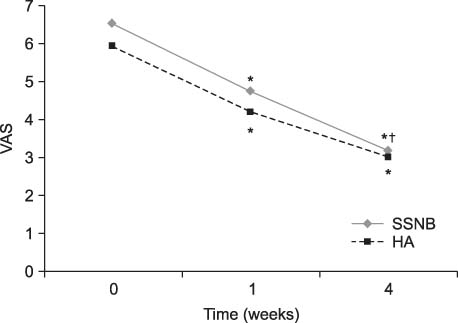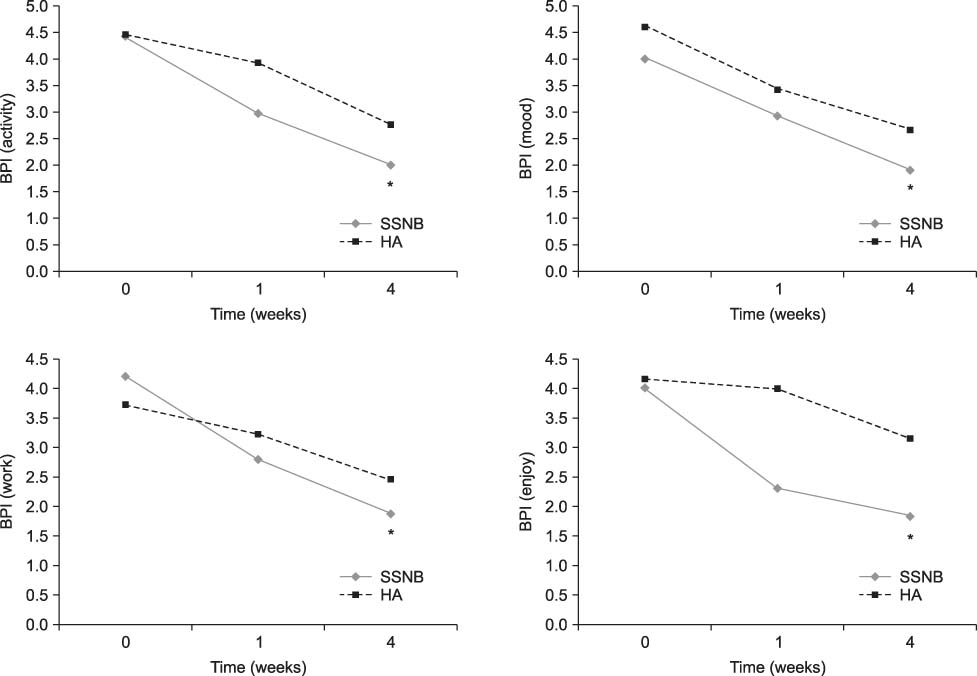Brain Neurorehabil.
2014 Sep;7(2):118-125. 10.12786/bn.2014.7.2.118.
Suprascapular Nerve Block versus Intra-articular Hyaluronic Acid Injection in Hemiplegic Shoulder Pain
- Affiliations
-
- 1Department of Physical Medicine and Rehabilitation, Soonchunhyang University College of Medicine, Korea. nickel0050@gmail.com
- KMID: 1797645
- DOI: http://doi.org/10.12786/bn.2014.7.2.118
Abstract
OBJECTIVE
To compare the pain and functional improvement of suprascapular nerve block (SSNB) and intra-articular hyaluronic acid (HA) injection in post-stroke patients with hemiplegic shoulder pain. METHOD: In total, 24 stroke patients were randomly assigned in the SSNB group (n = 12) or the HA group (n = 12). Ultrasound (US) guided SSNB with 10 cc of 1% lidocaine and US guided intra-articular injection with 2 cc of HA was done in each group 3 times weekly. Visual analogue scale (VAS), Fugl-Meyer scale (FMS), Wolf motor function test (WMFT), Brunnstrom stage, modified Ashworth scale (MAS), range of motion (ROM) of shoulder joint and brief pain inventory (BPI) concerning the interference of patient's function (activity, mood, walking, work, relationship, sleep and enjoy) were assessed before the injection, one week and four weeks after first injection.
RESULTS
Both groups showed significant improvements in pain assessed by VAS, but the changes between the two groups were not significantly different. There were no significant improvements and did not show any significant differences between the two groups in FMS, WMFT, Brunnstrom stage, MAS and ROM of shoulder joint. On several items of the BPI concerning the interference of patient's function (activity, mood, work, and enjoy), only SSNB group showed significant improvement, even though the differences between the two groups were not significant.
CONCLUSION
Both SSNB and intra-articular HA injection were safe and effective in pain and functional ability in hemiplegic shoulder pain. But comparing the interference of patient's function caused by pain, only SSNB showed significant improvement.
Keyword
MeSH Terms
Figure
Reference
-
1. Yasar E, Vural D, Safaz I, Balaban B, Yilmaz B, Goktepe AS, Alaca R. Which treatment approach is better for hemiplegic shoulder pain in stroke patients: intra-articular steroid or suprascapular nerve block? A randomized controlled trial. Clin Rehabil. 2011; 25:60–68.
Article2. McLean DE. Medical complications experienced by a cohort of stroke survivors during inpatient, tertiary-level stroke rehabilitation. Arch Phys Med Rehabil. 2004; 85:466–469.3. Snels IA, Dekker JH, van der Lee JH, Lankhorst GJ, Beckerman H, Bouter LM. Treating patients with hemiplegic shoulder pain. Am J Phys Med Rehabil. 2002; 81:150–160.
Article4. Yoon TS, Kim DH, Park JW, Kwon BS, Ryu KH, Lee HJ, Park NK, Shim JH. Causes of the hemiplegic shoulder pain. J Korean Acad Rehabil Med. 2010; 34:158–162.5. Ward AB. Hemiplegic shoulder pain. J Neurol Neurosurg Psychiatry. 2007; 78:789.
Article6. Zeilig G, Rivel M, Weingarden H, Gaidoukov E, Defrin R. Hemiplegic shoulder pain: evidence of a neuropathic origin. Pain. 2013; 154:263–271.
Article7. Niessen MH, Veeger DH, Meskers CG, Koppe PA, Konijnenbelt MH, Janssen TW. Relationship among shoulder proprioception, kinematics, and pain after stroke. Arch Phys Med Rehabil. 2009; 90:1557–1564.
Article8. Chantraine A, Baribeault A, Uebelhart D, Gremion G. Shoulder pain and dysfunction in hemiplegia: effects of functional electrical stimulation. Arch Phys Med Rehabil. 1999; 80:328–331.
Article9. Kim HW, Kim HS, Ahn KH. The effect of intraarticular injection of hyaluronic acid and steroid in adhesive capsulitis of shoulder. J Korean Acad Rehabil Med. 1999; 23:117–123.10. Inaba MK, Piorkowski M. Ultrasound in treatment of painful shoulders in patients with hemiplegia. Phys Ther. 1972; 52:737–742.
Article11. Lakse E, Gunduz B, Erhan B, Celik EC. The effect of local injections in hemiplegic shoulder pain: a prospective, randomized, controlled study. Am J Phys Med Rehabil. 2009; 88:805–811.12. Lim JY, Koh JH, Paik NJ. Intramuscular botulinum toxin-A reduces hemiplegic shoulder pain: a randomized, double-blind, comparative study versus intraarticular triamcinolone acetonide. Stroke. 2008; 39:126–131.13. Murie-Fernandez M, Carmona Iragui M, Gnanakumar V, Meyer M, Foley N, Teasell R. Painful hemiplegic shoulder in stroke patients: causes and management. Neurologia. 2012; 27:234–244.14. Rah UW, Yoon SH, Moon DJ, Kwack KS, Hong JY, Lim YC. Subacromial corticosteroid injection on poststroke hemiplegic shoulder pain: a randomized, triple-blind, placebo-controlled trial. Arch Phys Med Rehabil. 2012; 93:949–956.
Article15. Sung SY, Kim DK, Seo KM, Kang SH, Park HJ. The effect of intramuscular low frequency electrical stimulation for hemiplegic shoulder pain. J Korean Acad Rehabil Med. 2008; 32:518–526.16. Adey-Wakeling Z, Crotty M, Shanahan EM. Suprascapular nerve block for shoulder pain in the first year after stroke: a randomized controlled trial. Stroke. 2013; 44:3136–3141.17. Lee KH, Khunadorn F. Painful shoulder in hemiplegic patients: a study of the suprascapular nerve. Arch Phys Med Rehabil. 1986; 67:818–820.18. Gorthi V, Moon YL, Kang JH. The effectiveness of ultrasonography-guided suprascapular nerve block for perishoulder pain. Orthopedics. 2010; 33.
Article19. Kim C, Park YB, Yoon JE, Kim DY. Treatment of adhesive capsulitis with steroid injection followed by hyaluronic acid injection. J Korean Acad Rehabil Med. 2010; 34:310–315.20. Price DD, McGrath PA, Rafii A, Buckingham B. The validation of visual analogue scales as ratio scale measures for chronic and experimental pain. Pain. 1983; 17:45–56.
Article21. Cleeland CS, Ryan KM. Pain assessment: global use of the brief pain inventory. Ann Acad Med Singapore. 1994; 23:129–138.22. Van Ouwenaller C, Laplace PM, Chantraine A. Painful shoulder in hemiplegia. Arch Phys Med Rehabil. 1986; 67:23–26.23. Boonsong P, Jaroenarpornwatana A, Boonhong J. Preliminary study of suprascapular nerve block (SSNB) in hemiplegic shoulder pain. J Med Assoc Thai. 2009; 92:1669–1674.24. Allen ZA, Shanahan EM, Crotty M. Does suprascapular nerve block reduce shoulder pain following stroke: a double-blind randomised controlled trial with masked outcome assessment. BMC Neurol. 2010; 10:83.
Article25. Turner-Stokes L, Jackson D. Shoulder pain after stroke: a review of the evidence base to inform the development of an integrated care pathway. Clin Rehabil. 2002; 16:276–298.
Article26. Shanahan EM, Ahern M, Smith M, Wetherall M, Bresnihan B, FitzGerald O. Suprascapular nerve block (using bupivacaine and methylprednisolone acetate) in chronic shoulder pain. Ann Rheum Dis. 2003; 62:400–406.
Article27. Di Lorenzo L, Pappagallo M, Gimigliano R, Palmieri E, Saviano E, Bello A, Forte A, DeBlasio E, Trombetti C. Pain relief in early rehabilitation of rotator cuff tendinitis: any role for indirect suprascapular nerve block? Eura Medicophys. 2006; 42:195–204.28. Woolf CJ. Somatic pain--pathogenesis and prevention. Br J Anaesth. 1995; 75:169–176.
Article29. Park KD, Nam HS, Lee JK, Kim YJ, Park Y. Treatment effects of ultrasound-guided capsular distension with hyaluronic acid in adhesive capsulitis of the shoulder. Arch Phys Med Rehabil. 2013; 94:264–270.
Article30. Byun SD, Park DH, Choi WD, Lee ZI. Subacromial Bursa Injection of Hyaluronate with Steroid in Patients with Peri-articular Shoulder Disorders. Ann Rehabil Med. 2011; 35:664–672.
Article31. Saito S, Furuya T, Kotake S. Therapeutic effects of hyaluronate injections in patients with chronic painful shoulder: a meta-analysis of randomized controlled trials. Arthritis Care Res (Hoboken). 2010; 62:1009–1018.
Article32. Blaine T, Moskowitz R, Udell J, Skyhar M, Levin R, Friedlander J, Daley M, Altman R. Treatment of persistent shoulder pain with sodium hyaluronate: a randomized, controlled trial. A multicenter study. J Bone Joint Surg Am. 2008; 90:970–979.33. Vieira AS, Baptista AF, Mendes L, Silva KS, Gois SC, Lima FM, Souza I, Sa KN. Impact of neuropathic pain at the population level. J Clin Med Res. 2014; 6:111–119.
Article34. Erdemoglu AK, Koc R. Brief Pain Inventory score identifying and discriminating neuropathic and nociceptive pain. Acta Neurol Scand. 2013; 128:351–358.
Article
- Full Text Links
- Actions
-
Cited
- CITED
-
- Close
- Share
- Similar articles
-
- The Comparison of Effects of Suprascapular Nerve Block, Intra-articular Steroid Injection, and a Combination Therapy on Hemiplegic Shoulder Pain: Pilot Study
- Intra-Articular Hyaluronic Acid Injection in Ankle Osteoarthritis
- Effects of Intra-Articular Injection and Subscapularis Motor Point Block on Painful Hemiplegic Shoulder
- Effect of Intra-articular Hyaluronic Acid Injection on Hemiplegic Shoulder Pain After Stroke
- The Effect of Intra-articular Hyaluronic Acid and Steroid Injection in Osteoarthritis of the Knee



